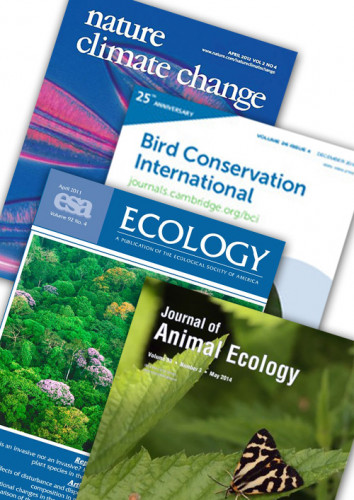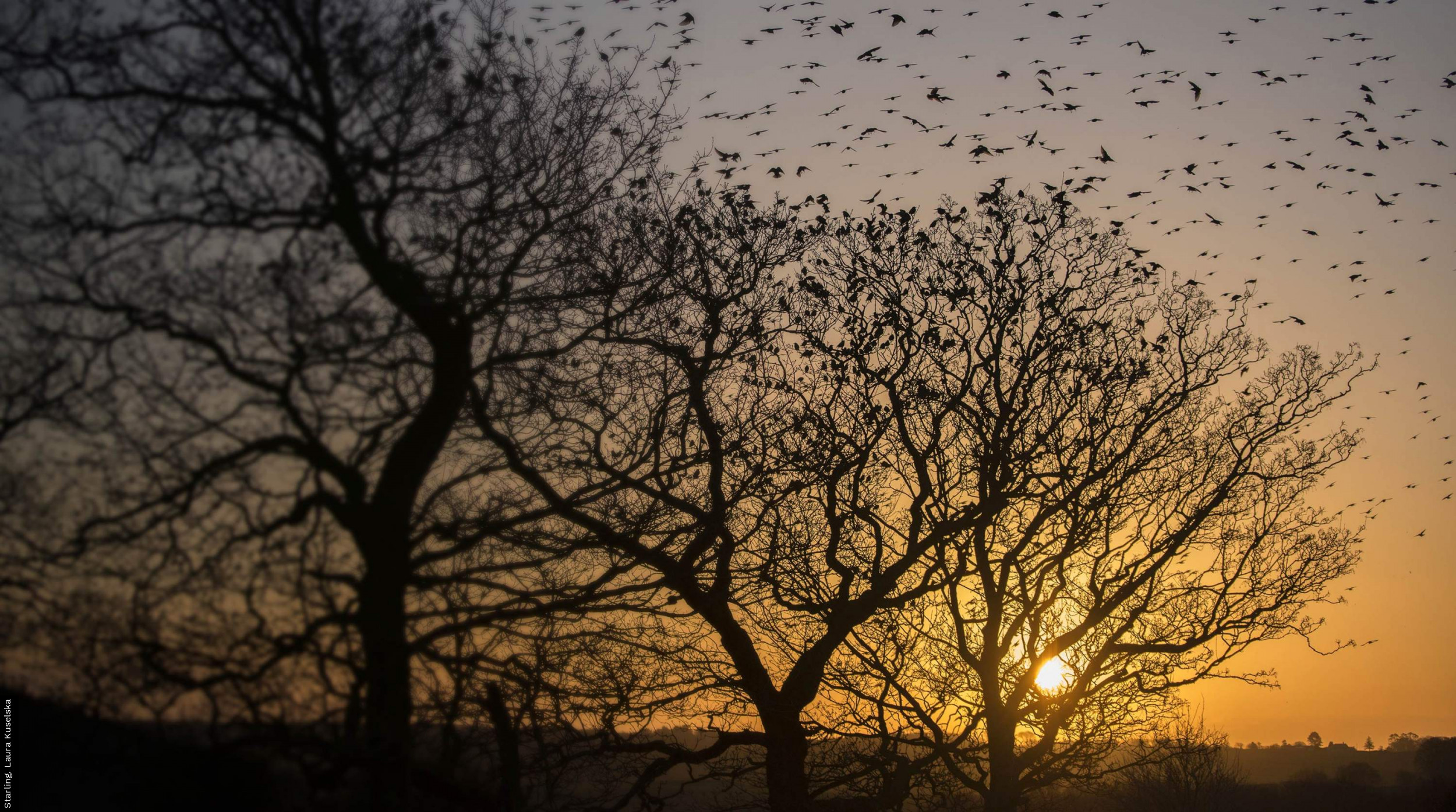Peer-reviewed papers

It is BTO’s policy to make public the results of our research. Our aim is to publish as much as possible of our work in the peer reviewed scientific literature. Many results are also published in our BTO Research Report series.
2017.
Nest monitoring does not affect nesting success of Whinchats Saxicola rubetra.
IBIS
Link to Article (DOI: 10.1111/ibi.12574)
2017.
Can bird abundance declines be detected by citizen science programmes? A case study using Common Cuckoo Cuculus canorus.
Avian Biology Research
10 (part 4)
: 241-245
View Abstract
Link to Article (DOI: 10.3184/175815617X15036738758862)
2017.
The sensitivity of breeding songbirds to change in seasonal timing is linked to population change but cannot be directly attributed to the effects of trophic asynchrony on productivity. .
Global Change Biology
Link to Article (DOI: 10.1111/gcb.13960)
2017.
Large-scale citizen science improves assessment of risk posed by wind farms to bats in southern Scotland.
Biological Conservation
215
: 61-71
View Abstract
Link to Article (DOI: 10.1016/j.biocon.2017.09.004)
2017.
Projected reductions in climatic suitability for vulnerable British Birds.
Climatic Change
145
: 117-130
Link to Article (DOI: 10.1007/s10584-017-2081-2)
2017.
Addressing Uncertainty in Marine Resource Management; Combining Community Engagement and Tracking Technology to Characterize Human Behavior.
Conservation Letters
10
: 460-469
View Abstract
Link to Article (DOI: 10.1111/conl.12293)
2017.
Implicit assumptions underlying simple harvest models of marine bird populations can mislead environmental management decisions.
Journal of Environmental Management
201
: 163-171
View Abstract
Link to Article (DOI: 10.1016/j.jenvman.2017.06.037)
2017.
Consequences of population change for local abundance and site occupancy of wintering waterbirds.
Diversity and Distributions
: 1 472-4 642
Link to Article (DOI: 10.1111/ddi.12653)
2017.
Bird and bat species' global vulnerability to collision mortality with wind farms revealed through a trait-based assessment..
Proc. R. Soc. B.
284
Link to Article (DOI: 10.1098/rspb.2017.0829)
2017.
Environmental correlates of breeding abundance and population change of Eurasian Curlew Numenius arquata in Britain.
Bird Study
64
: 393-409
View Abstract
Link to Article (DOI: 10.1080/00063657.2017.1359233)
2017.
Predicting the impacts of wind farms on seabirds: An individual-based model.
Journal of Applied Ecology
55
: 503-515
Link to Article (DOI: 10.1111/1365-2664.12996)
2017.
Monitoring the biodiversity of regions: Key principles and possible pitfalls.
Biological Conservation
214
: 23-34
Link to Article (DOI: 10.1016/j.biocon.2017.07.034)
2017.
Characterising demographic contributions to observed population change in a declining migrant bird.
Journal of Avian Biology
48
: 1-11
View Abstract
Link to Article (DOI: 10.1111/jav.01305)
2017.
A national-scale assessment of climate change impacts on species: assessing the balance of risks and opportunities for multiple taxa..
Biological Conservation
213
: 124-134
View Abstract
Link to Article (DOI: 10.1016/j.biocon.2017.06.035)
2017.
Low and annually variable migratory connectivity in a long-distance migrant: Whinchats Saxicola rubetra may show a bet-hedging strategy.
Ibis
View Abstract
Link to Article (DOI: 10.1111/ibi.12509)
2017.
Stand structure and breeding birds in managed Scots pine forests: Some likely long-term implications for continuous cover forestry.
Forest Ecology and Management
397
: 174-184
Link to Article (DOI: 10.1016/j.foreco.2017.04.039)
2017.
Exploring the lives of Goshawks in the Brecks: identifying patterns in nest behaviour, habitat use and movements within and beyond the Brecks.
The Journal of Breckland Studies
1 (part 1)
: 19-27
2017.
A New Approach to Modelling the Relationship Between Annual Population Abundance Indices and Weather Data.
Journal of Agriculture, Biological and Environmental Statistics
: 1-19
Link to Article (DOI: 10.1007/s13253-017-0287-4)
2017.
Climate change vulnerability for species—Assessing the assessments.
Global Change Biology
23 (part 9)
: 3 704-3 715
Link to Article (DOI: 10.1111/gcb.13759)
2017.
A bird's eye view: using circuit theory to study urban landscape connectivity for birds.
Landscape Ecology
32
: 1 771-1 787
View Abstract
Link to Article (DOI: 10.1007/s10980-017-0548-1)
2017.
What are the forthcoming legislative issues of interest to ecologists and conservationists in 2012?.
Bulletin of the British Ecological Society
43 (part 1)
: 12-19
View Abstract
2017.
Sample size required to characterize area use of tracked seabirds.
The Journal of Wildlife Management
Wiley
View Abstract
Link to Article (DOI: 10.1002/jwmg.21283)
2017.
No short- or long-term effects of geolocator attachment detected in Pied Flycatchers Ficedula hypoleuca.
Ibis
View Abstract
Link to Article (DOI: 10.1111/ibi.12493)
2017.
Quantifying the importance of multi‐scale management and environmental variables on moorland bird abundance.
Ibis
159 (part 4)
: 744-756
Link to Article (DOI: 10.1111/ibi.12488)
2017.
Tawny Owl Strix aluco response to call-broadcasting and implications for survey design.
Bird Study
64 (part 2)
: 205-210
View Abstract
Link to Article (DOI: 10.1080/00063657.2017.1315047)
2017.
The decline of a population of farmland breeding waders: a twenty-five-year case study.
Bird Study
64 (part 2)
: 264-273
Link to Article (DOI: 10.1080/00063657.2017.1319903)
2017.
Effects of deer on woodland structure revealed through terrestrial laser scanning.
Journal of Applied Ecology
54 (part 6)
: 1 615-1 626
Link to Article (DOI: 10.1111/1365-2664.12902)
2017.
Continuing influences of introduced hedgehogs Erinaceus europaeus as a predator of wader (Charadrii) eggs four decades after their release on the Outer Hebrides, Scotland.
Biological Invasions
19
: 1 981-1 987
Link to Article (DOI: 10.1007/s10530-017-1422-4)
2017.
A global threats overview for Numeniini populations: synthesising expert knowledge for a group of declining migratory birds
.
Bird Conservation International
27
: 6-34
View Abstract
Link to Article (DOI: 10.1017/S0959270916000678)
2017.
Predicting the likely impact of urbanisation on bat populations using citizen science data, a case study for Norfolk, UK.
Landscape and Urban Planning
162
: 44-55
Link to Article (DOI: 10.1016/j.landurbplan.2017.02.005)
2017.
Migratory pathways, stopover zones and wintering destinations of Western European Nightjars Caprimulgus europaeus.
Ibis
Link to Article (DOI: 10.1111/ibi.12469)
2017.
Potential for coupling the monitoring of bush-crickets with established large-scale acoustic monitoring of bats.
Methods in Ecology and Evolution
8
: 1 051-1 062
Link to Article (DOI: 10.1111/2041-210X.12720)
2017.
Neglected issues in using weather and climate information in ecology and biogeography.
Diversity & Distributions
Link to Article (DOI: 10.1111/ddi.12527)
2017.
Doses of neighborhood nature: the benefits for mental health of living with nature.
BioScience
67 (part 2)
: 147-155
Link to Article (DOI: 10.1093/biosci/biw173)
2017.
Large extents of intensive land use limit community reorganization during climate warming.
Global Change Biology
23
: 2 272-2 283
Link to Article (DOI: 10.1111/gcb.13587)
2017.
Towards a framework for quantifying the population-level consequences of anthropogenic pressures on the environment: The case of seabirds and windfarms.
Journal of Environmental Management
190
: 113-121
Link to Article (DOI: 10.1016/j.jenvman.2016.12.025)
2016.
The seabird wreck in the Bay of Biscay and South-Western Approaches in 2014: A review of reported mortality.
Seabird
29
: 22-38
View Abstract
2016.
An indicator highlights seasonal variation in the response of Lepidoptera communities to warming.
Ecological Indicators
68
: 126-133
View Abstract
Link to Article (DOI: 10.1016/j.ecolind.2016.01.057)
2016.
A novel method for quantifying overdispersion in count data and its application to farmland birds.
Ibis
Link to Article (DOI: 10.1111/ibi.12450)
2016.
Density-dependence and marine bird populations: Are wind farm assessments precautionary?.
Journal of Applied Ecology
Link to Article (DOI: 10.1111/1365-2664.12841)
2016.
Habitat selection by breeding Whinchats Saxicola rubetra at territory and landscape scales..
Ibis
159
: 139-151
Link to Article (DOI: 10.1111/ibi.12433)
2016.
Demographic drivers of decline and recovery in an Afro-Palaearctic migratory bird population.
Proceedings of the Royal Society B
283 (part 1 842)
View Abstract
Link to Article (DOI: 10.1098/rspb.2016.1387)
2016.
Multi-state multi-stage modeling of nest-success suggests interaction between weather and land-use.
Ecology
98
: 175-186
View Abstract
Link to Article (DOI: 10.1002/ecy.1629)
2016.
First formal estimate of the world population of the Critically Endangered spoon-billed sandpiper Calidris pygmaea.
Oryx
52 (part 1)
: 137-146
Link to Article (DOI: 10.1017/S0030605316000806)
2016.
Impacts of climate change on national biodiversity population trends.
Ecography
View Abstract
Link to Article (DOI: 10.1111/ecog.02411)
2016.
Updated risk of H5N1 HPAI incursion to poultry in Great Britain via wild birds.
Veterinary Record
179
: 464-464
Link to Article (DOI: 10.1136/vr.103700)
2016.
Human activities and biodiversity opportunities in pre‐industrial cultural landscapes: relevance to conservation.
Journal of Applied Ecology
54
: 459-469
Link to Article (DOI: 10.1111/1365-2664.12762)
2016.
Investigating the impact of street lighting changes on garden moth communities.
Journal of Urban Ecology
2 (part 1)
Link to Article (DOI: 10.1093/jue/juw004)



Share this page